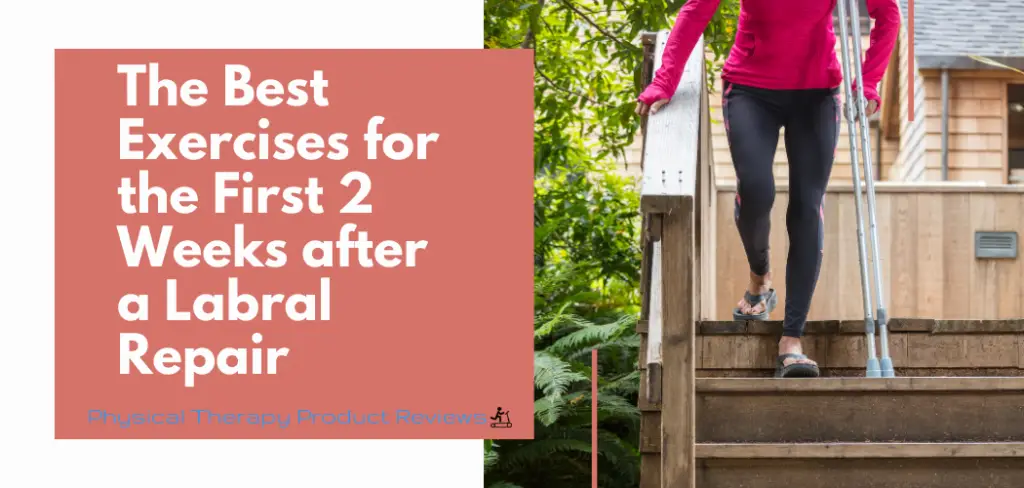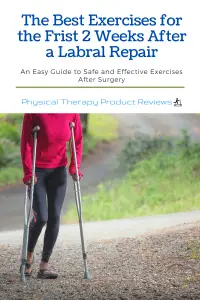 The first 2 weeks after a hip labral repair surgery can be both frightening and exciting all at the same time. You can’t wait to get back to a pain-free lifestyle but you also don’t want to do any damage to your new surgery.
The first 2 weeks after a hip labral repair surgery can be both frightening and exciting all at the same time. You can’t wait to get back to a pain-free lifestyle but you also don’t want to do any damage to your new surgery.
Yet you are sitting around waiting and can feel like you are doing nothing at all.
With a little guidance, we will share the best and safest exercises that you can start in the first 2 weeks after a labral repair.
Disclaimer: Always consult with your surgeon before doing any exercise, each surgeon has a different protocol after surgery. Despite these being safe and effective, it is up to you to check first.
Different Types of Hip Labral Surgeries
There are 3 main types of labral hip surgeries so it’s important to know which procedure you had done and to follow those guidelines.
Labral Debridement
A Labral Debridement is where the surgeon goes in and cleans up the labrum and the surrounding tissue. The labrum can get frayed and those loose fibers can be a source of pain. This surgery is the least invasive and fastest recovery because nothing was actually repaired.
Labral Repair
A Labral Repair is where the surgeon with try and repair the existing labrum where it might be torn or damaged. This is often done with sutures that are anchored into the hip joint itself. This surgery does take longer to heal because there are tissue and bone that need to heal from an actual surgical repair being performed.
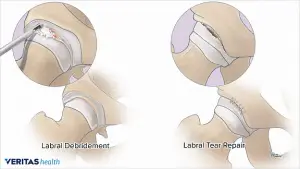
Labral Reconstruction
This is the most invasive and longest to recover from. In this surgery, the hip socket, the ball of the hip, or both may be modified and reshaped to avoid further hip problems. The labrum is usually re-built using another piece of tissue such as the IT band or cadaver tissue.
Goals for the First 2 Weeks After Arthroscopic Labral Repair
- Protect the new surgery - When in doubt just take it easy. The main goal at this time is to let the hip heal and allow the anchors in the labrum to take hold.
- Decrease Pain and Swelling - There is inevitably going to be pain and swelling after surgery. These exercises can help with both but make sure that they aren’t increasing either.
- Get Muscle Firing Again - After surgery, muscles will shut off because of pain, swelling, and the nervous system trying to protect the body. By using the muscle and getting good at activating them you can speed up recovery.
- Always maintain Surgical precautions
Precautions After a Hip Labral Repair
There are important precautions that you will need to follow after surgery to make sure that the surgery has time to heal. Even though these exercises may seem simple to some you’ll notice that you’ll feel better after doing them and they are safe and effective after this type of surgery.
You won’t be able to do the same type of labral exercises that you were doing before surgery, it’s important to be cautious after surgery.
Important Note: Each surgeon will have a different set of restrictions. Please check with your surgeon
- No Hip Flexion beyond 90°
- No Hip Extension beyond 0°
- Hip External Rotation 20° – 30°
- No Hip Abduction 25° or greater
- No Hip Internal Rotation and Adduction limits
- Avoid Sitting @90° of Hip Flexion x 2 weeks
Maintain Weight-Bearing Restrictions using Bilateral Crutches at Partial Weight Bearing (<20 lbs.) x 3-4 weeks
An important way to avoid a flare-up of the hip flexors is to use foot-flat weight-bearing while still maintaining your weight-bearing precautions.
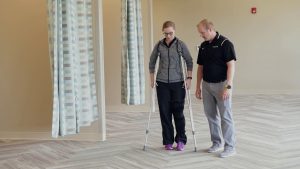
By just keeping your hip flexed during toe-touch weight-bearing while using crutches, your hip flexor muscles are working and tight ALL THE TIME. Don’t put more weight on the foot but just lets the foot relax flat on the floor to protect your hip flexors.
Do not push through the pain in any activity at this stage. Nothing should hurt more than a 3-4/10.
The Best Exercises Post Labral Repair for the First 2 Weeks
Ankle Pumps
Start by lying on your back sitting in a chair with your legs elevated. Bend your ankle up and down as far as you can. This helps prevent blood clots in the legs, improves circulation, and keeps your calf muscle from losing strength.
Try to perform 20 repetitions 4-6x a day
Video Link: https://www.youtube.com/watch?v=KxfFzSOAT7g
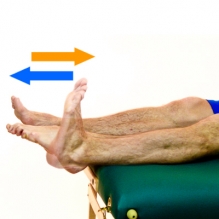
Lay on Stomach (minimum of 20 min. 3x/day)
This is easy but important to do. Find an area that has some support like the floor or an exercise mat and lie on your stomach. Be sure to be cautious getting on the floor. The goal of this is to stretch on the front of the hip safely. The first few times you do this you might need a pillow underneath the hips and gradually decrease the height until you are fully straight on the floor.
Perform 3x a day at 20 minutes
Video Link: https://www.youtube.com/watch?v=Nx6l_KHNVXY
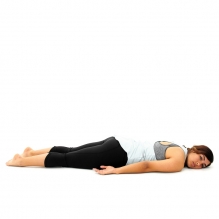
Quad Sets (hold 10 sec.)
This exercise is all about getting the muscles on the front of the thigh awake and ready. Start by lying on your back with your legs out in front of you flat on the bed or floor. Try and squeeze your thigh muscles while pushing your knee down to the floor. Hold for 10 seconds. You can place your hands on your thighs to see if you are getting enough muscle firing.
Perform 10 repetitions 4-6x a day
Video Link: https://www.youtube.com/watch?v=sCTE0RFlb3o
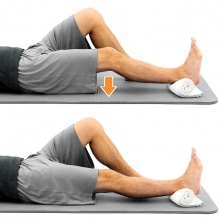
Glute Sets (hold 10 sec.)
This exercise may be the most important on the list for a couple of reasons. It helps get our biggest and most critical hip muscles working faster after surgery. Secondly, it can help with pain in the front of the hip through something called the Gate Pain Control Theory. Finally, it helps relieve pressure on the front of the hip where the vast majority of labral tears and repairs are located.
Start by lying flat on your back and try to squeeze your glutes (or butt muscles) as hard as you can and hold for 10 seconds. Be sure you check to see if you are squeezing your glutes and not your hamstring muscles. After 10 seconds relax and do it again. You can do this exercise all day long and you don’t have to be sitting when you try to do it.
Perform 10 repetitions 4-6x a day
Video Link: https://www.youtube.com/watch?v=LmT6h6YFADk
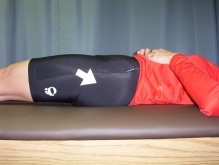
Pelvic Tilts (hold 10 sec.)
Start by lying on your back with your knees bent. Place your first 2 fingers just inside your pelvic bone to feel the abdominal muscles. Draw in your belly button toward your spine as you tighten your abdominal muscles and flatten your back down to the floor. Your fingers should feel the ab muscles tighten. Hold this abdominal tightening for 10 seconds while still breathing normally. Relax and perform again.
Perform 10 repetitions 2-4x a day
Video Link: https://www.youtube.com/watch?v=44D6Xc2Fkek
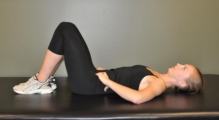
Cat and Camel 2×10 (5 sec holds)
Getting into the starting position can be tough, so be careful but it’s a great exercise to get things moving. Carefully get into quadruped or on your hands and knee. While keeping a little weight in the surgical leg, begin to arch your back up to the ceiling. Hold for 3 seconds, and then round your back in the opposite direction. This helps teach your body to move the hips and the lumbar spine in the correct movement patterns. The light and gentle weight-bearing in the surgical hip also helps promote healing.
Perform 2×10 repetitions 2-4x a day
Video Link: https://www.youtube.com/watch?v=JJkjIKlimW8
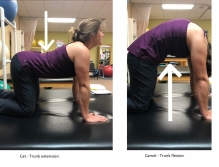
Self-Massage Techniques After a Labral Tear
Muscle massage is a great way to help with pain control and muscle tightness after surgery, however, not many people can afford a weekly massage.
If you can talk a loved one into massaging the front, sides, and back of the hip then that’s great and something of benefit. Even 15 minutes every other day is great to promote blood flow in the area.
Sometimes loved ones are nervous that they will cause more harm than good, but there is no way that they will do any damage as long as they aren’t moving the leg too much.
If you want to massage the area on your own you can use a portable massage gun or a self-myofascial massager. Try and massage around the incision, and all sides of the hip. The hip flexors are commonly tight after surgery and are a great area to use the massage gun on.
Our favorite massage guns are the Hydragun Massage Gun and the Legiral Massage Gun.
Conclusion:
The first few weeks after a labral tear is a time for rest and recovery however some simple, safe, and effective exercises can help speed up your recovery. With the self-massage described and the exercises, you’ll be able to get back to your favorite exercises faster and stronger.
As always, check with your surgeon before starting any exercise routine.
Works Referenced:
Harris JD. Hip labral repair: options and outcomes. Curr Rev Musculoskelet Med. 2016 Dec;9(4):361-367. doi: 10.1007/s12178-016-9360-9. PMID: 27581790; PMCID: PMC5127940.
Wolski D, Mather RC 3rd. Surgical Treatment of Labral Tears: Debridement, Repair, Reconstruction. Curr Rev Musculoskelet Med. 2019 Sep;12(3):291-299. doi: 10.1007/s12178-019-09575-1. PMID: 31346980; PMCID: PMC6684681.
White BJ, Patterson J, Scoles AM, Lilo AT, Herzog MM. Hip Arthroscopy in Patients Aged 40 Years and Older: Greater Success With Labral Reconstruction Compared With Labral Repair. Arthroscopy. 2020 Aug;36(8):2137-2144. DOI: 10.1016/j.arthro.2020.04.031. Epub 2020 Apr 28. PMID: 32360267.
Other Great Rehab Related Articles
Dealing with Painful Stairs After Ankle Replacement Surgery
Walking After a Total Ankle Replacement: Tips for a Successful Recovery
Exercises While Non-Weight Bearing After Ankle Replacement: Elevation, AROM, Leg Raises, and More
Ankle Pain with Stairs: Causes and Home Treatment Options
5 Common Mistakes You’re Making After an Ankle Sprain
6 Great Ways to Reduce Low Back Pain with Driving
Disclaimer: The information provided in this post is for educational purposes only. This is not a substitute for a medical appointment. Please refer to your physician before starting any exercise program.
